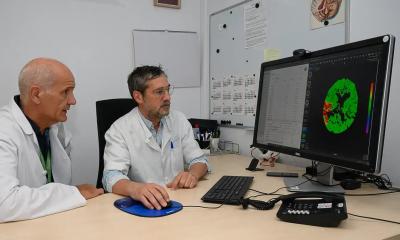Hippocrates meets Medusa's head
Informed consent in radiology today
Fide splendet et scientia
By Dr J Larsen MD FRCR, Consultant Radiologist at Braunschweig Hospital, Germany

Contemplating patients’ views on radiological investigations and procedures leaves me worried: While radiologists may feel plagued by the issues surrounding informed consent for their activities in which the relationship with their patients is often brief and episodic, we cannot deny that some of these have led to devastating outcomes. In fact, most would agree that the spectrum of radiological activities is wider ranging today than anyone would have foreseen even twenty years ago and that we are no longer able to predict all possible circumstances that may occur during the frequently complex diagnostic and therapeutic measures that have been adopted. This article reviews current thinking on informed consent, highlighting key concepts and problem areas.
Informed consent is the key process at the medico-legal interface. While the total number of law suits is small, considering the total number of studies performed, with 8% of respondents stating involvement in malpractice suits in the context of use of intravenous contrast media leading to neurological impairment or death, obtaining consent is integral to medical practice today. In 1914, Justice Benjamin Cardozo developed the legal doctrine of informed consent, i.e. that a competent adult should have the right to control their medical care. Doctors are obliged to respect this and disregarding it constitutes an assault.
Different types of consent, applying to different types of procedure, exist. One must distinguish so-called implied from express consent. For example, we may imply consent when a patient willingly climbs on to an examination table, while express consent must be explicitly a statement that requires the patient to be informed. Legal precedents have evolved into two principal court approaches: The prudent physician, or reasonable practitioner concept, uses a standard set by a physician testifying as an expert which the particular case is tested against. By contrast, the later concept of the prudent or reasonable patient standard is more demanding, placing the physicians standard with the court (1972). It is determined as what a reasonable patient would have wanted to know, based on the personal knowledge and experience of jury or judge. However, there is no need to disclose all known information on a procedure and these concepts have evolved with time. A trend towards the prudent patient standard is evident and growing, but legal uncertainties remain.
The current practice in radiology departments across the world is variable and considerable discrepancies exist with respect to legal requirements. This is due both to differences in attitudes, perceptions and opinions as well as practicalities. Specifically, consent forms have been found to lack important detail, being too complex and frequently poorly understood. In a cross-sectional readability study, sample texts exceeded the standard by 2.8 grade levels. Nonetheless, considering, for example, contrast media administration, when standardised information is given, 5% of patients raise questions leading to 1% refused uses and the use of an alternative agent in another 1%. Misconceptions also exist: The long-believed theory that informing patients of particular risks of procedures may heighten their anxiety, in turn making the occurrence of complications more likely, has been refuted by Hopper who found that a significant increase in anxiety only occurred when patients were not being informed about what was going to happen to them. Finally, misconceptions also exist on the patient’s side: In a recent study by Akkad, only 41% of individuals questioned believed that it was the purpose of the forms to make their wishes known.
The issue of informed consent is clearly complex and must be seen in the context that the patient-doctor relationship has evolved into a legal contract to provide the best possible care. Obtaining consent has thus become part of a physician’s responsibility, requiring disclosure of risk-benefit assessments (paraphrased from Hetts 1995).
Various problems, legal and medical, remain and are subject to controversy. The conceptual legal approaches have already been mentioned. Specific requirements between states, nationally and internationally, may be considerably different.
For example, there are varied regulations in place about who should obtain consent. In Germany, doctors themselves are called upon, while in the UK the task may be delegated, although the ultimate responsibility remains with the radiologist. Equally, it is not self-evident who can actually give consent, i.e. who is able to comprehend, understand and consent, or refuse. Bush has coined the term ‘specific patient standard’ for this requirement, while Munn refers to the situation of a patient who does not want to be informed as ‘patient-requested non-informed consent’. Furthermore, there is dispute regarding for which procedure consent is required: Clearly, if it carries a material risk, i.e. that a complication is either common or serious, when its occurrence may constitute a major life event, informed consent should be obtained.
However, different views exist as to what represents a significant incidence, i.e. one that requires the patient to be informed. Perhaps we should consult with patients even for simple diagnostic procedures involving, for example, ionising radiation, especially when CT is concerned. Nonetheless, the extent of any information given may be at different levels, depending on the procedure: giving contrast media may demand less than the administration of sedation or vice versa? There is agreement that full consent must be obtained for all interventional procedures such as drain insertion, percutaneous biopsy and catheter angiography. How exactly consent is obtained, how much information is given and the time point at which consent is obtained are again debatable. Both written and oral formats are valid, often supported by patient information sheets provided in advance. However, on post-procedure testing of four degrees of counselling no statistical difference has ever been found between a written statement of common risks (level 2) and counselling about all known risks by a physician (level 4). Principal information should include the nature of the procedure, the anticipated result, alternative measures available, recognised benefits and risks, including any risk should the patient decide not to proceed with the suggested examination or intervention. The patient will then have to evaluate these factors, balance them and decide. Obtaining consent even a day prior to major, complex procedures may be too late (German Federal Court 2007). Special considerations apply in the following circumstances, but are beyond the scope of this review: Use of non-approved or recycled devices, emergencies (3% of cases), patients with limited understanding due to intellectual, language or illness-related difficulties (11%), sedated patients, intimate examinations, imaging in the context of research and teaching (in particular relating to incidental findings of pathology), minors (2%), screening and detainees. However, such discussion is to some extend esoteric since practical limitations of time and staffing supervene. Hopper has estimated that counselling about all known risks by a physician may take as much as 7% of professional time.
Comprehensive advice as how to cast these considerable details into a usable consent process has been given, amongst others, by Bush in 1994, by Berlin in 1997 and again by The Royal College of Radiologists (RCR) in 2005. It appears prudent to first determine any legal requirements at your place of work. A workable consent process would then include a written policy, written procedure information and consent forms that consider readability standards, aiming at an 8th grade level of understanding. Information given should be basic, including common risks and risk factors. It may be helpful to teach patients to recite procedural risks (White 1995). Considering the dynamics during the consenting process as a dialogue, radiologists should perhaps obtain consent themselves. Hetts suggests that, by doing so, doctors are seen as an individual committed to providing the best care humanly possible. The process requires proper documentation, particularly in the context of non-informed consent. We should finally be consistent in the use of our policy. In addition, guidelines, as given by the RCR, should be non-prescriptive and will assist in determining the level of consent required for particular diagnostic and interventional procedures, reflecting current practice but considering global or general standards that may supersede community standards. In the end, obtaining informed consent is particular to individual cases and comes down to making a judgement and taking a decision.
In conclusion, if we do consider the most personal features of the patient-doctor relationship integral to obtaining informed consent, we may consider the most anecdotal evidence. In my own experience, I have seen patients most at ease, and myself most satisfied, when we could talk in good time and somehow outside the constraints of today’s busy radiological practice. So, we should perhaps make this the rule, approaching patients open-mindedly, considering their needs and engaging with their views and offering ours or, as a long-running British Telecom advertisement campaign said: It’s good to talk.
A referenced version of this article is available upon request by contacting the author at jlarsenmd@hotmail.com.
30.10.2007











